 Got Cat Fleas? Feline Fleas Treatment – What Works | What Doesn’t
Got Cat Fleas? Feline Fleas Treatment – What Works | What Doesn’t
Got Fleas ?
Kill Cat Fleas-
Safe, Natural Flea Treatments That Work
Controlling cat fleas when there is a big infestation at home can send your stomach to the pits, your blood pressure to the heavens and your sanity down the tubes. Your cats may be scratching non-stop — overnight — and some may already have developed a nasty allergic reaction to the flea bites.
It only takes one little flea to inflict major damage on a sensitive cat, with resulting sores, flaky skin, incessant scratching and even bald, weeping hot spots that get continually licked. Bad infections can ensue if not treated. A few fleas in the household can usually be managed fairly well with regular clean up of household and some natural fleas treatment for your cat and environment.
A major flea infestation that shows up like the plague out of nowhere may make you think you were cursed in a last life…and broke a couple mirrors in this one! Good news is that you already have two main battle weapons to fight the dastardly parasite known as the Cat Flea. The trusty wash machine and vacuum cleaner are star performers in the flea battle arsenal.
When a cat flea infestation booms — and sometimes overnight — then things can get way out of control, especially if you have more than one cat and/or a large house and premises.
What to do to fight this dastardly flea foe?
Good News. You CAN beat the Flea.
Bad News. It isn’t always easy.
When a fleas infestation is booming, you need strong resolve, good tools at your command and consistent, feline flea control action until the battles add up to the war won. From there, you can take a breath — although you must always remain vigilant, since fleas can live all year round in heated homes in winter as well. And you must maintain regular flea-busting tactics.
Good news again… those measures of feline fleas treatment are what you are likely doing anyway. Regular laundry, thorough vacuuming and cleaning of pet areas, flea combing and baths as needed are safe, natural flea treatments that work! With heavy infestations, you just have to do them more often. Sometimes daily.
If fleas are out of control – seemingly everywhere – you may need to pull out some heavier weapons from the natural fleas treatment arsenal. You hear everywhere how frantic people can get. Some are livid that the feline flea treatment product they used didn’t work. The fleas were still there –or BACK!
♦ One tries an amethyst stone in the water bowl.
♦ Another puts on the popular and oh-so-convenient Spot-On insecticides on their cats. (but alarming reports of toxicity)
♦ Still another tries some DE or sprays on some vinegar and washes the cats bed.
♦ Another puts family and cats and other pets’ lives all at risk by bombing the home with poisons, applying med after med on his poor cat, trying toxic suggestions from someone they read on a forum without doing due diligence …and just using anything that ‘might’ work because they are so sick and tired of the flea misery. Yet the pesky fleas REMAIN…and sometimes get worse! And possibly –cats have been harmed. And possibly family members too!
What GIVES!!! What’s a desperate person to do?

SIMPLE.
Understand the enemy!
And RESOLVE to put in ALL the work it will take to eliminate a flea invasion.
And KEEP At It! (and use the least toxic methods possible)
- We simply CANNOT do one or two things and think the job is done!
- The Fleas WILL NOT be defeated.
- They WILL still be there!
- They will multiply and CONTINUE to plague us!
WHY?!! Because we don’t understand the flea life cycle…what their weak points are… and how to use them to DEFEAT them!
Fleas come in four different ‘shapes’ — four stages of their life cycle.
We must target these life stages and disrupt at least one to two of them to kill them off . AND — we must do so IN THREE BATTLE AREAS.
Read on to find out How You Can Win the Flea War!
SO – HOW to KILL FLEAS!?
 An integrated feline flea combat plan is required and must be carried through without falter, or your line of offense will be weak and the flea WILL find a way through.
An integrated feline flea combat plan is required and must be carried through without falter, or your line of offense will be weak and the flea WILL find a way through.
FOCUS: 2-3 LIFE STAGES in ALL THREE
BATTLE ZONES.
You MUST attack a Flea on at least
THREE FRONTS – At the SAME TIME:
-
ON your CAT
-
IN the HOUSE
-
IN Your YARD
You Must Also Battle 2 – 3 LIFE STAGES of the Cat Flea in these 3 Battle Zones
Since the flea evolves through a four-stage life cycle, treating just ONE stage will NOT do the trick. As mentioned above, often people think that because they applied some spot-on flea treatment (or gave their cat a bath, or combed through fur until no other fleas were found, or whatever flea treatment they gave their cat) and killed off the adults, their job is done. Then they become outraged at the vet or flea control product used when fleas show up again. Remember, there are THREE OTHER STAGES of fleas developing in your house and yard, all emerging at different times, laying more eggs and perpetuating the miserable process of flea combat. And nasty existence for your poor cat.
The Numbers of Fleas in the Environment exceed the number of fleas you can see on your cat – in multiples!  Cat fleas are the most common flea found on our cats and dogs. Dog fleas, on the other hand, usually prefer wildlife. Cat fleas will also infest many other animals that may lurk around your yard: raccoons, opossum, birds, chipmunks or coyotes and even farm animals you may harbor. The cat fleas can easily be transported into the house after being picked up by your feline during an outdoor sojourn or brought inside by you or a guest as a hitchhiker on clothes. You can bring home fleas from the vet’s office! Or from someone else’s home with dogs or cats or other domestic pets that can harbor fleas. Fleas WILL show up again and again and again…unless we hit them in all stages of their development. (Egg, larva, pupa, adult) Usually, disrupting one or two stages of the four will win the war. The final stage before emerging as an adult , the pupa, is VERY difficult to eradicate. Flea eggs, too, can be very resistant to any harm we can inflict. Here’s a SUMMARY of CAT FLEAS TREATMENT – – Details and Insight Follow –
Cat fleas are the most common flea found on our cats and dogs. Dog fleas, on the other hand, usually prefer wildlife. Cat fleas will also infest many other animals that may lurk around your yard: raccoons, opossum, birds, chipmunks or coyotes and even farm animals you may harbor. The cat fleas can easily be transported into the house after being picked up by your feline during an outdoor sojourn or brought inside by you or a guest as a hitchhiker on clothes. You can bring home fleas from the vet’s office! Or from someone else’s home with dogs or cats or other domestic pets that can harbor fleas. Fleas WILL show up again and again and again…unless we hit them in all stages of their development. (Egg, larva, pupa, adult) Usually, disrupting one or two stages of the four will win the war. The final stage before emerging as an adult , the pupa, is VERY difficult to eradicate. Flea eggs, too, can be very resistant to any harm we can inflict. Here’s a SUMMARY of CAT FLEAS TREATMENT – – Details and Insight Follow –
| SUMMARY – Natural Cat Flea Treatments
Must Treat ALL 3 ZONES at SAME TIME ADULTS – Kill ON CAT, Indoor ENVIRONMENT, Outdoor Yard Use SAFE Powders listed below, Followed by Repellants, Baths, Flea EGGS – Treat Cat as above. Vacuum, Launder. Treat Indoors and LARVAE – Treat Indoors with Safe Powders listed, Consider Indoor Spray Outdoors with listed Flea Treatments, Keep Lawn mowed, PUPAE – Very difficult to kill. Treat Environment Indoors and Out as _____ If you interrupt any stage of the Flea Life Cycle, you are a big
AND KEEP AT IT! Encourage hatching with vacuuming…and be ready with your other MAINTAIN Regular Vacuum – Laundry – Cat Combing/Baths/Bedding As Flea Season approaches – Go Into FULL Swing and Take Until the first HARD FROST hits…fleas will survive outdoors. They will emerge from somewhere the first time conditions are Fleas will also survive the winter in our heated homes, and of STAY VIGILANT! If your Cat scratches – suspect fleas – check it out And for the sake of You, Your Family, Your Cats and Pets… |
FLEA TREATMENT BATTLE PLAN
Natural Fleas Treatment – Commercial Considerations
Home Flea Treatment – How to Kill Fleas
 – What Worked to Conquer and Control Cat Fleas –
– What Worked to Conquer and Control Cat Fleas –
Successful home cat flea treatment included consistent and diligent treatment of the cat, the household and the yard. The information and products mentioned here are NOT recommendations, but information on various means of cat flea control as well as personal experience with successful tactics in the battle waged here at the sanctuary for multi-cat flea treatment for major flea infestations experienced. You must do your Own due diligence to kill fleas in conjuction with your personal knowledge of your cats, their physical conditions (ie. eldlerly, sensitive, in treatment for other conditions, ability to administer specific fleas treatment to specific cats…etc. and proper consultation with your vet.
OUR NATURAL FLEA TREATMENT BATTLE WEAPONS:
(with some Commercial Tools)
|
|
- DE – for Adults
- BORAX – for Larvae, Eggs
- SALT – Adults (Add Salt to Borax or Baking Soda to kill the Adults, Larvae and Eggs)
- BAKING SODA – Larvae, Eggs (Mix with equal parts salt for adults ) Can add drops of cedar oil ( Or 1-2 drops of other essential oils- CAREFUL – TOXIC for cats)
- STEAM CLEAN (pressurized vapor) – Eggs, Larvae, Adults
Should you NOT have your carpets full of DE, Borax and/or Salt — Can Use VAPOR Steam Cleaner (Temp. MUST be 140 degrees F or Above) to Kill eggs, larvae and adults.
Try Vacuuming thoroughly, then steam cleaning. Allow to dry and then add powder treatments.
Steam Cleaning ALONE is not likely to eliminate a flea population. Just can’t reach into all the places fleas can hide. But it can zap a good number that you can reach!
Combine either DE or Salt with Borax or Baking soda for cat flea treatment to hit at least three stages of cat fleas.
- Combine your choice of natural dry treatments listed above to kill adults, fleas and eggs in the home.
- Use IGR sprays in household (to prevent any future eggs laid from hatching. NOTE: this is a CHEMICAL –not natural — option)
- Apply least toxic chemical choice of adulticide (ie. Nitenpyram) on your cat to kill off biting adults. (Consider use of IGR treatment in some form to prevent future eggs from hatching on cat (or continue with nitenpyram, DE, repellants)
The pupa stage is very difficult to treat with any insecticides or natural treatments. The adult flea can survive for a year or more wrapped safely inside that impervious cocoon! Disrupting three of the four stages will bring relief to your cat, to you and your household. Vacuuming, with its heat and vibrations, encourages flea larvae to move around the carpeting to get sucked up in the vacuum and it tricks pupae into hatching into adults. (Vibrations, heat, light and shadow changes are like ‘alarm clocks’ to signal flea pupae to hatch and begin their adult feeding frenzy.) Hopefully, the regimen listed here and the flea treatments that worked here for our cats will help unravel the mystery of difficult Flea Combat. Why do fleas keep returning — even after flea treatment was implemented?
- You simply did not treat all areas needed
- Or – didn’t hit enough of the stages of the flea life cycle
- And you may have stopped too soon!
We must be vigilant, persistent and consistent.
Feline Fleas are a Sneaky Bunch
Even after the last adult flea has shown itself, there may be more hatching eggs, larvae and pupae that were not able to be killed. Feline Fleas are master survivors! So BE READY with the vacuum, the adulticide, and the wash machine! They are effective, basic feline flea treatments!
| The Vacuum Model Used Here at ‘Oasis’ for Cat Clean Up Lightweight, Affordable – But does HEAVY Work Well – Just like the BIG Guys! |
Vacuuming daily is wise for one to two weeks or more after the fleas treatment. It is work…but it can help you catch any fleas that could be hatching daily.
It is usually recommended to wait two weeks to reapply any insecticides, to allow fleas that weren’t killed first round – along with those seemingly indestructible pupae-to hatch. Vacuuming can trick them into hatching sooner, as well as bringing the larvae up from the depths of the carpet to where you can suck them up, as mentioned. Vacuuming also removes the food supply of any larvae in the carpet, so they will starve and you’ll have fewer to worry about and can just vacuum them away. And the more you catch now, the fewer that have to be treated when that two weeks roll around. You are preventing more eggs from being laid, and thus interrupting reproduction.
I retreated the carpets with borax, salt and baking soda the second time, just for good measure. I waited only one week. Even though Borax is said to last about 3 – 6 months, be prepared to reapply more often as needed. Chemical applications may only require a 2 week interval. Or try a different combo the second time, such as salt and balking soda, or combine all three.
I reserve DE for the areas where the cats will repose, sleep and be more likely to groom themselves. DE doesn’t seem to last as long as an environmental treatment, but works well on cats and in up close bedding etc, where you can just leave it without fear of ingestion when they groom themselves. In fact, DE can help fight tapeworms and other parasites when your cat licks it off. From there – continue vigilance for any signs of new fleas showing up on your cats or other pets, VACUUM regularly and keep that wash machine in order!
Flea Treatments for The Three Battle Lines
Cat ~House ~ Lawn and Yard
1. Cat Treatment for Fleas –
Natural Fleas Treatment and Commercial Flea Control
![]() Attack Adults with Capstar (Nitenpyram) on cat.
Attack Adults with Capstar (Nitenpyram) on cat.
Lasts 24 hours.
- Immediate Relief-fast acting.
- Can be reapplied daily if necessary.
- Good for kittens, cats sensitive to other treatments
Can also consider application of IGR product as oral, spot on or injection if comfortable with additional chemical and form of application.
Said to be ‘safe’. Some concerns reported of possible flea resistance developing with IGRs. IGR treatment stops any new eggs from hatching and any eggs from new fleas that might be introduced after the initial flea fight was brought under control. It must be applied monthly like the spot-ons, except for the injection, which is reported to last 6 months. Likely better choice than spot-on (also deemed ‘safe’ but files of evidence of harmful reactions continue to grow; flea resistance mounts with each new formulation and even deaths reported) but some concern reported that flea resistance to IGR’s may be happening – something thought not to be likely.
IGR product will stop eggs from hatching – but does NOT kill adult fleas. They must Bite your cat to ingest the insecticide, which will prevent their eggs from hatching. Useful if cats go outdoors frequently, where new fleas can be introduced. (Full flea control elimination using only IGR flea treatment would take about 4-6 weeks). IGR products used on cats best if all cats confined from outdoor contact or other cats not treated. All cats in household should be treated at same time.
- Kill Adult fleas with MUCH safer Capstar (nitenpyram). IGR then would prevent the eggs of any new adult fleas that bite from hatching if you felt confident in application.
New adult fleas can be introduced at any time – you, dogs, guests can bring in fleas. Can pick up at vet’s office. So Flea Battle Weapons should always be at the ready. Regular flea combing, vigilance, vacuuming and laundering should help keep any new stray fleas in check.
![]() Bathe cat in soapy water to drown fleas
Bathe cat in soapy water to drown fleas 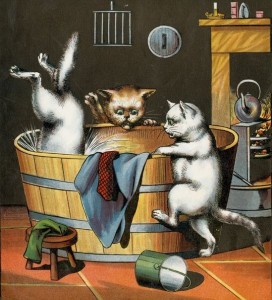 – Use flea comb to catch as many fleas as you can while you bathe cat – Add cedar oil to water if desired. Use formulation only specified for cats
– Use flea comb to catch as many fleas as you can while you bathe cat – Add cedar oil to water if desired. Use formulation only specified for cats
- – Do NOT use any other essential oils on cats (Any other oils used in other products MUST be HIGHLY diluted)
Soap helps relieve surface tension of water to keep fleas from finding a safe haven to hide out in and survive..like air bubbles.
![]() Apply Flea Repellant to Keep Feline Fleas Away Consider a Natural Flea Repellant to use on regular basis. Cedar oil works, (Use ONLY Cat-Specific Formulation!) but the smell is not appreciated by cats or the household, although some people love it. It has been applied to cats who sojourn outside, before they leave the house. Then a combing, DE treatment or Capstar is given if any scratching is noticed when they come back in. (Usually a combo of all three.)
Apply Flea Repellant to Keep Feline Fleas Away Consider a Natural Flea Repellant to use on regular basis. Cedar oil works, (Use ONLY Cat-Specific Formulation!) but the smell is not appreciated by cats or the household, although some people love it. It has been applied to cats who sojourn outside, before they leave the house. Then a combing, DE treatment or Capstar is given if any scratching is noticed when they come back in. (Usually a combo of all three.)
There are various herbal flea repellant formulas that can be purchased as well. Just be sure to do your due diligence and check ingredients to make sure that permethrins, citrus or essential oils are NOT included in quantity, if at all. (Essential oils must be HEAVILY diluted to be used.) They are toxic to cats…yet sold widely nonetheless.
Equal parts of apple cider vinegar (or white if you can handle the smell) and water are sponged or sprayed on. This seemed to work for a senior cat that was plagued with spasms of flea dermatitis and repeated attacks due to her weak state. It DID seem to calm her almost immediately. And no signs of scratching or wild spasmodic episodes appeared again for three days. She didn’t like the application process — it was sponged on with a wash cloth rather than sprayed, which she hates, and then, since she was quite wet, she dried herself out on the elevated deck outside. She did lick it off over the days. It needn’t be applied so wet, but it just worked out that way, and actually was for the best. It seems to be effective about three days if enough is applied. You can also dip a flea comb into a container of the apple cider/water solution and comb it through your cat’s coat.
- Apple cider vinegar is touted for health benefits for people and pets. And numerous anecdotal reports exist about the improved quality of various elements of their cats’ health and appearance. It is still used here, often applied to any cats who are going outside – sometimes when coming back in as well.
You can also put a tsp. into your cats’ water bowl. Many swear by the repellant qualities that build up over time. And report that the fur takes on a glossy sheen.Since none of the cats here at Oasis will drink the water…even with less than a tsp., no results to report here. Apple cider is applied externally for flea repellant and they ingest it as they groom, but it is not continued year round, nor done continuously. So fleas aren’t being naturally repelled over the long haul by current or past applications but short term applications have helped.
![]() Apply DE to cats – Brush into fur or rub in.
Apply DE to cats – Brush into fur or rub in.
- Use ONLY Food Grade (organic) DE! (The Pool form is VERY DANGEROUS to people and pets!!! Pool type DE is heated and chemically treated and can cause SERIOUS harm to people and pets that breathe it in, and in the case of cats that groom, also ingest it!)
Food Grade DE is not harmful, but used widely in our grains, with cattle and as medicinal supplement for a variety of ailments by people. It is used to kill tapeworms and other parasites as well safely. Just don’t inhale it, or raise a lot of dust when applying to your cats so that they don’t breathe it in. It is drying and will irritate. Like inhaling talcum powder or baking soda. Wear a mask if you have respiratory conditions just to avoid any possible hassles. - Can reapply regularly. Not harmful if ingested –and they will lick it off. ( Fights tapeworm and parasites when ingested. Add tsp to food daily)
- Apply to cat before going out and coming in if needed
- Apply generously to cat bedding and all areas where cats spend time. Rub in so that it isn’t inhaled. Leave it intact; vacuum up regularly and replace.
- Don’t breathe in or allow cats to breathe in.
I use a soft baby brush, dip it into my container of DE (kept separate from the whole bag) and brush the DE into the cats’ coats. I start at the neck and head and then go to the tail and brush the DE in against the fur to get it down towards the skin. Then I apply to the belly and get into the armpits and then apply more to the cat all over, brushing WITH the fur growth for good measure. The cats LOVE the ‘massage’ and will jostle for position to get their flea treatment! I even have some of them competing to stick their heads in the container and lick the DE directly! This alerts me to watch for any conditions, too, that might need attention.
Apply enough to work a decent amount in, but beware of doing too much. One thing to Note: I’ve noticed that one cat developed constipation, which I think may be attributed to ingesting the DE when he licked it off — which, of course cats will. And that is more than fine, as it is a great nutritional supplement and fights internal parasites. However, if there is too much applied for a specific cat… or if applied frequently, the drying effect may cause them to stop up. There is no study or report I’ve seen anywhere to confirm this, but this is what I observed here with one cat. He had a bad case and it took a while to unblock him. And he was quite miserable.
Applying less to him seems to have worked, as I have not had the situation repeated after the second time, when a bit less was applied…but obviously not a big enough reduction. None of the other cats had a problem. He checked out OK at the vet otherwise. There is no way to be sure what is ‘too much’..it is trial and error, but obviously, don’t make them dustballs or let their coats turn white. Just work a small amount into each section of body and watch for the effects. If it doesn’t seem to help, then try more. If they respond with any reactions, as my little guy did, reduce or eliminate the DE flea treatments on the cat and use it in the environment and bedding.
Be sure to watch any cats that are having problems in the litter box and adjust accordingly. Any cats with kidney problems should likely not have DE applied, since they are usually in need of extra fluids, and if they should react as our one little guy, that would a complication you don’t want for a cat with such a delicate condition. I would apply DE to their bedding generously, and around the areas where they spend time, but make sure they wouldn’t be able to ingest more than a tsp. or so if that for this condition. Just my observations, but I am quite confident about what I experienced before the reduction of DE and after. You might try 1 tsp. of DE daily in their food to help with parasites or tapeworms, but that small amount is sufficient. If problems are noticed…discontinue use — and be especially observant of any cats with kidney problems. It may be too drying…and cats with kidney conditions need more fluids, not less. 
| DE – Diatomaceous Earth can be found in farm supply & some hardware stores. I found it in Home Depot also. (Get FOOD GRADE – NOT the type for pools or aquariums —DANGEROUS!) |
![]() Comb cat with Flea Comb regularly to catch adult fleas (and some larvae and eggs)
Comb cat with Flea Comb regularly to catch adult fleas (and some larvae and eggs)
- Drown fleas in soapy container of water as you comb your cat regularly.
![]() Treat for Tapeworm If your cats have fleas – count on them having tapeworm as well. Fleas are hosts for tapeworm. If your cat ingests a flea with a tapeworm, it will get them too. It’s almost a given. So I just expect to treat for this other parasite when fleas show up.
Treat for Tapeworm If your cats have fleas – count on them having tapeworm as well. Fleas are hosts for tapeworm. If your cat ingests a flea with a tapeworm, it will get them too. It’s almost a given. So I just expect to treat for this other parasite when fleas show up.
It is not unusual to have to do it often if fleas persist. Left untreated, cats can get thin and anemic and more susceptible to whatever else comes around they can catch. With bad flea infestations, the worm problem can also become worrisome
In a multi cat rescue such as this, it is difficult shouldering the burden of treatment costs. I fortunately found a GREAT solution! Well … at least a bit of cost shock relief. Tapeworm tabs are so expensive from the vet and slightly cheaper online. I discovered a super value by purchasing the generic active ingredient, called ‘Praziquantel’ at 12 mg, the same dose as from the vet. A hundred pack, (but you can buy smaller packs) chicken flavored in capsule form, which I’ve found easier to administer. Can open and put in food, but even with the flavoring, you risk the cat not eating it. So I’m able to get the capsule down some cats without problem; for the others, I mix it in a bit of chicken broth or liquefied canned food and syringe it in. So much easier than the tabs and the savings are significant. I buy online. See links. (Hint: I buy the generic form of Capstar – Nitenpyram as well at great savings. And both work just the same as the expensive vet forms because they are they same ingredients. NOTE: The powders don’t always dissolve completely, so if using a syringe, make sure it has a large enough opening so it doesn’t plug up.
![]() Provide Quality Nutrition to Fight Cat Fleas –
Provide Quality Nutrition to Fight Cat Fleas –
– Natural Flea Treatment from Inside Out
Parasites target the weak and ill. Keeping your cat healthy helps keep all sorts of nasty creatures at bay. Fleas included. They may still attack, but not overwhelm a healthy cat. 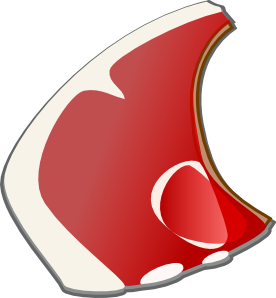 Feed your wonderful cats a premium, healthy feline specific diet. Fresh, raw foods of quality are most natural and most recommended. Feeding raw can be difficult, but raw and frozen foods are now available for cats. High-quality canned food is superior to dry kibble. It simply has more meat protein, which cats, as carnivores, must have to survive and avoid illness.
Feed your wonderful cats a premium, healthy feline specific diet. Fresh, raw foods of quality are most natural and most recommended. Feeding raw can be difficult, but raw and frozen foods are now available for cats. High-quality canned food is superior to dry kibble. It simply has more meat protein, which cats, as carnivores, must have to survive and avoid illness.
Dry kibble is heavy carbohydrate based and is not what cats would find if necessary to hunt for themselves (which is not recommended in this day and age in most areas). Cat systems and metabolism aren’t geared to even handle starchy carbohydrates, which is a staple of most cheap dry cat kibble – essentially ‘junk food’ with supplements added for marketing in so many products. None-the-less, many cats are’ addicted’ to their kibble, due to focused lab research by pet food companies, who know what types of flavorings and textures will keep cats interested. And how to put the right pictures and verbiage on the package to keep us buying it. And since cats are very much creatures of routine, it is hard to introduce new things. (Best to start your cats out on the proper food from the beginning when you first adopt your new cat.)
But then, witness how difficult it can be to ‘wean’ some of our species from their junk food…fast foods, snacks, sugared/salted/coated/colored chemical-laden gobbledeegook that is sold as food in these times. The parallel is there with our cats. But it can – and should – be done. Substitute about 1/4 to 1/3 of the new food and increase a bit each day over a few weeks, until your cats accept the new diet. If you can’t feed daily, even supplementing once a week or so is beneficial. Feeding more quality canned food as well as using it to help to transition to raw foods is far superior to any kibble diet.
(Again, cats in the wild don’t hunt for kibble — they eat fresh — important adjective – and raw. Their natural diet. They don’t flock to corn fields or hover outside cereal factories if forced to fend for themselves. Yet much kibble is laden with such ingredients. Unfortunately, most lost, homeless and also feral cats are forced to find garbage or infected or poisoned wildlife to survive, and some won’t know how to hunt effectively as former domestic family members. They were never taught and the instincts may not be strong.)
In short, the more quality canned food and less kibble you can adjust your cat to, the better. Shooting for a raw food diet is ideal.
2. Household Flea Treatment
![]() Attack adult fleas, eggs, larvae in household with DE, Borax, Salt, Baking Soda
Attack adult fleas, eggs, larvae in household with DE, Borax, Salt, Baking Soda
— or any combo of DE or Salt for the adults with Borax or Baking Soda for the larvae and eggs.
– Apply to bedding, furniture, carpeting, cracks, crevices
- Be careful not to breathe in the dusts or allow cats to.
- Work well into carpets with broom or rake. Leave for 36 hours or more before vacuuming. (The longer period is better. Leaving merely 24 hours or just a few may not be long enough to dry out the fleas. I believe people don’t see enough success with Borax or these dry flea treatments because they don’t leave them on long enough to give them time to work on the fleas in the application areas
- Keep family and pets off treated areas until after vacuuming well. Borax can poison if ingested.
- Test fabrics for colorfastness before using Borax. Can also be abrasive to carpets, especially when used over time.
- If humid weather, these dry treatments may not be usable. Could be messy with moisture. Try applying early in day, vacuuming 3 – 5 hours later. Reapply for a few days.
- Vacuum twice at least to remove treatments to get as much ‘dust’ as possible and dead fleas, eggs, larvae.
- Vacuum daily for a week or so. If more adults seen, Reapply and start process again. Continue as long as needed.
- After fleas are conquered, continue regular vacuuming regimen
NOTE: Do NOT allow ingestion or inhalation of BORAX..it can poison! Keep rooms off limits to cats and family until thoroughly vacuumed. Even though considered a ‘natural’ fleas treatment, and SAFE when used PROPERLY — Do not handle without gloves if skin is broken; boric acid, if used, readily penetrates broken skin.
While Borax is not boric acid, they are derivatives of boron and they work the same. Oral ingestion of boric acid, for instance, is quick and complete and concentrates in the brain and liver. I put down newspapers over the areas where traffic was needed – ie…path to front door, so that nothing stuck to shoes, feet or clothes or was tracked elsewhere. Tiny amounts won’t likely hurt…but no chances are taken. You never know how any cat – or human – might react to ANY exposure to toxic substances.)
NOTE: You can purchase Borax (20 Mule Team Brand is popular} at you local grocery or discount stores. Boric acid, which is not needed, is harder to find.
Easier Alternatives?
Two Products – FleaBusters Rx for Fleas and FleaGo Natural Flea Control are ‘enhanced’ borax treatments composed of borates and other ingredients that are said to facilitate easier application. The borates in FleaBusters, for instance, are treated to make the powder very fine and combined with other ingredients to make application easier than regular borax, per manufacturer. Guaranteed to last up to one year. So this may be worth consideration, since the home remedies ‘powders’ may need additional applications. Have not tried these more ‘natural’ flea treatments here. My guess is they work well, since DE is effective.
Please SHARE/COMMENT below if YOU have found these flea treatments to be effective!
– Apply Insect Growth Regulator (IGR) Spray after Powder treatments to inhibit hatching of any eggs. Let Dry Thoroughly before allowing cats or family access! Can Use IGR that includes an added adulticide in place of powder treatments (borax, baking soda, salt) since the adults as well as the pre adult fleas are then handled.
I used Siphotrol Plus and Siphotrol Plus II (IGR products) with adulticide ( much more toxic potential due to adulticide….MUST use with care.) One is aerosol, the other spray bottle Used borax and salt treatment prior to arrival of products to contain flea population. IGR treatment said to last 7 months.
![]() Vacuum household thoroughly to kill fleas
Vacuum household thoroughly to kill fleas
(Your Vacuum – one of the most effective of household tools for feline flea control – KEEP it in use regularly!)
- All places pets repose or sleep, all places nearby, carpets, cushions, bedding -yours and cats’, under furniture, in closets, baseboards, along walls
- Vacuum DAILY if infestation is large ..fleas will hatch daily …Get them before they lay more eggs! DISRUPT their reproduction!
![]() Wash in hottest water and soap ALL items where cats congregate
Wash in hottest water and soap ALL items where cats congregate
- Cat bedding, sheets, afghans, blankets, curtains (especially those that hang to floor), clothing in cat areas that they may have slept on, ANYTHING that may contain larvae and flea eggs that fell off your cat as it rested or slept…or walked around in house
- Wash cat bedding and any other affected items regularly to wash away fleas
Consider use of IGR premise spray in around household to prevent future eggs from hatching. (It must be used with care. Allow to dry thoroughly before allowing cats or family access.)
![]() Steam clean carpets and floors (NOT for untreated wood floors)
Steam clean carpets and floors (NOT for untreated wood floors)
- Kills fleas, eggs, larvae
- MUST use HIGH TEMPERATURE STEAM – 140 degrees F or More!
- Regular carpet steamer won’t likely work. Could make problem WORSE. Temp not hot enough to kill fleas. Provides heat and humidity fleas love!
- VAPOR STEAM CLEANER recommended – gives dry, pressurized steam and high temps to kill fleas, mites– and if over 165 degrees F, e. coli too.
- Steam hard surfaces 1 inch/second; fabrics – 1/2 inch per second
- Professional steam cleaner could be called – can be expensive.
Heat and moisture are IDEAL elements that help fleas thrive. Temps 140 degrees and more will KILL them.
3. Flea Treatments for Lawn, Yard and Outdoor Buildings
- Spray shaded, moist areas where cats lay with cedar oil or other IGR preparations for yard
- Spray around foundations, under plants and in garden areas where cats repose
- Spray kennels or enclosures where cats reside or play
- Sunlit areas of yard likely too hot for fleas to linger – so not necessary to treat
- Keep lawn mowed so that sunlight can reach soil to heat it high enough to kill any fleas
- Water lawn regularly and deeply to drown fleas
- Use nematodes if available – said to be best in moist, sand-like soil. Use ONLY if chemicals NOT applied!
- Sprinkle DE around foundation, in kennels, enclosures, where cats linger, in buildings, bedding, etc. (Need to reapply if gets wet)( Note- do NOT use Borax outside – it kills plants.)
- Mix DE and salt to sprinkle around foundations, crevices, crawl spaces, near any potential entry way for insects – and where your cats or other pets will not go. The salt could be harmful if ingested by pets. The mixture will dry up larvae, adults and eggs and keep many types of insects from entering.
PLEASE KEEP in MIND that DE will ALSO kill off BENEFICIAL Insects, so be mindful of where you apply it! Around foundations and in attics and elsewhere where the ‘pest’ or harmful insects linger are prime areas for treatment. Your organic gardens and flower beds may not be the best places. Confine any DE, perhaps to the spots where your cats repose in those areas. Put down a special mat or rug for them where they enjoy lounging and treat that well, for instance.
NOTE: Do NOT Use Borax or derivatives Outdoors — it will KILL plants!
Something I am considering: Plant marigolds and lavender in the yard, along property lines and near fences where squirrels, birds, chipmunks, raccoons, possum and stray pets can linger, cross over or through…bringing their fleas with them. Marigold and lavender are said to repel fleas. If cats eat leaves, they may, however, suffer some vomiting and gastric distress. (Essential oils are derived from these plants) However, lavender and the NON-TOXIC form of Marigolds for fleas treatment (there are Both) are deemed safe for cats. My cats seem to prefer grass to any flowers…but if this is tried, there will be very close supervision none-the-less. Read my Update on Flea Repellants:
Natural Flea Treatment for cats — flea predators | flea repellant plants.
Ants and spiders devour fleas, so they should be protected. If using insecticides, check labels to see if they will be killed along with the fleas. Use carefully.
Although spiders will not directly hunt fleas, any that end up in their webs will make tasty dinner morsels for the smart spider.
If you can manage to avoid panic of allowing benign spiders to occupy some out of the way corners in the house – do let them reside. They won’t hurt you, but do much for you and your cats by grabbing those stray fleas (just one of which could produce up to 2000 more in a short lifetime of a couple months) and other critters you don’t want hanging about.
Ants outside do much heavy duty work in keeping fleas and other critters at bay. They are here for a purpose too…and in this instance, they serve us well.
The ONLY good flea in THIS sanctuary…is a dead one! :-}
Flea Treatment for Cats –
 – What Doesn’t Work –
– What Doesn’t Work –
![]() Dietary-Based Fleas Treatment Dietary supplementation for flea treatment has shown to be the least effective of natural home flea treatments.
Dietary-Based Fleas Treatment Dietary supplementation for flea treatment has shown to be the least effective of natural home flea treatments. * Vitamin B supplements, brewer’s yeast and garlic have not shown sufficient evidence to work to repel fleas. Some people swear by them, but scientific tests done failed to show significant repellant effects. And they do NOT KILL fleas in any form. *But they are good dietary supplements to enhance the immune system.
* Vitamin B supplements, brewer’s yeast and garlic have not shown sufficient evidence to work to repel fleas. Some people swear by them, but scientific tests done failed to show significant repellant effects. And they do NOT KILL fleas in any form. *But they are good dietary supplements to enhance the immune system.
Dr. Richard Pitcairn noted that Yeast had some beneficial effect for cats, but usually when the cats are healthy. While not efficient repellants in themselves, they are thought to effect overall health positively, which deters fleas.
** Kyolic garlic is the only form of garlic that is thought to be safe to use in cat health treatments – and only in small amounts. And there is debate out there on that. Check FIRST with your vet in regard to your specific cat…Different conditions can mean different reactions in individual cats. There is no evidence that this form of garlic repels or kills fleas.
- None of the items KILL fleas.
- NOTE: ** Garlic (and onions) should NOT be used with cats. It is toxic and can cause severe anemia. (It has also caused harm in dogs) Very Tiny amounts of garlic (Kyolic garlic preferred by holistic practitioners) used for medicinal purposes may do no lasting harm, but the amount of garlic needed to cause the ‘smell’ that would cause fleas supposedly to flee would be hazardous to a cat. (any use of garlic should be cleared with a knowledgeable health practitioner for your cats)
- CHECK WITH YOUR VET before using any natural substances before risking your cat’s health. Each cat is different and has a different health status as well. Even if one cat came showed no harm done, YOUR cat may react differently. It may be older, much younger without proper immune protection in place or may harbor a condition of which you are not aware and have totally different reactions than another cat. Taking chances – not worth the risk!
- * NOTE: B vitamins (also Brewer’s Yeast) are healthy supplements in proper amounts. Anything that contributes to a healthy immune system and overall healthy cat will help keep fleas, parasites and other diseases at bay. Proper doses and formulations should be species specific and discussed with your vet and/or cat’s holistic medical practitioner.
![]() Essential Oils should NEVER be used on cats due to toxicity. If they swallow them or if they are used full strength, they can cause miserable reactions and could kill your cat. Cats’ livers cannot quickly eliminate toxins from essential oils and a buildup of toxins could kill your feline love.
Essential Oils should NEVER be used on cats due to toxicity. If they swallow them or if they are used full strength, they can cause miserable reactions and could kill your cat. Cats’ livers cannot quickly eliminate toxins from essential oils and a buildup of toxins could kill your feline love.
- Cats are very sensitive to items that dogs, for instance, might not be. A cat’s make up and metabolism just simply cannot handle some of the seemingly ‘benign’ substances – ‘natural’ or otherwise that people want to try on their animals.
PLEASE do due diligence before trying anything on or around your cats or pets about which there is no certainly or you do not understand.(Please NOTE that many natural substances and essential oils are ALSO very toxic to dogs. See Colorado State University – Natural Approaches to Flea Control)
Following something heard on a forum or from a neighbor or friend without first checking with your vet to see if such a substance could cause harm is very dangerous. If your vet or practitioner sees no possible harm from a substance, then your own personal study with your cat and the results – if positive — would be helpful to all. Some vets may nix any ideas of ‘holistic’ or natural treatments. They aren’t taught holistic practices and may not have ventured to learn about them personally. Be that as it may, the MAIN THING we must ascertain is, if there is any likely HARM that any substance might inflict. THAT your vet should know, unless it is something unusual. Blindly trying things made for people, dogs or other animals could result in you creating serious harm and even death to the beloved cat you are trying to help.
- Never apply essential, or volatile oils, full strength on a cat, directly to the cat’s body or in any way that the cat can lick it off or swallow any oils. Small amounts can kill!
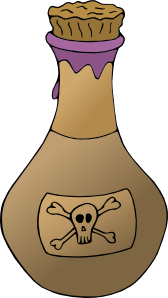 Some of the most toxic essential oils are used in cat shampoos, flea repellants, collars, flea and tick treatments and mosquito repellants. Holistic stores and websites sell a number of blends with the same toxic substances.
Some of the most toxic essential oils are used in cat shampoos, flea repellants, collars, flea and tick treatments and mosquito repellants. Holistic stores and websites sell a number of blends with the same toxic substances.
The most toxic known are: pennyroyal, eucalyptus, tea tree, sage, rosemary, tansy, thyme, hyssop, cinnamon, wormwood and camphor. All ‘friends’ to you and me for various types of afflictions. We have an enzyme that can quickly process out the toxins — cats do not. I’ve read labels of some of these products that recommend using full strength on cats, such as flea treatment shampoos. According to Colorado State University, this can kill your cat. Only HEAVY DILUTION of essential oils for the purpose of flea treatment or other uses is workable. Complete, thorough rinsing is necessary to remove any traces of oil left the fur before a cat grooms itself. The max amount of any an essential oil like eucalyptus added to a shampoo, for instance, should only be one or two drops! Mosquito repellants made for humans should NEVER be used on cats. They contain toxic essential oils!
![]() Insecticidal and Ultrasonic flea collars
Insecticidal and Ultrasonic flea collars
*NOTE : Flea collars (insecticidal or IGR) are short-term treatments, and should only be used a MAXIMUM of six days. After that time, remove them. For future use, store in a sealed container.
HOWEVER — Flea collars embedded with insecticides are NOT recommended for any pets! They can be dangerously toxic and affect only the area around the neck is affected at any rate. The fleas just move elsewhere, while your cat’s fur and skin continue to be exposed to the poisons. And if it scratches and licks its paw, it may be ingesting some as well. Your cat suffers more than the fleas from these poisons. They have been deemed ineffective from all reports I’ve seen.
![]() Diatomaceous Earth (DE) and other drying powders like borax and salt, DO WORK – and although effective, may prove unsuccessful in humid regions or during periods of high humidity anywhere.
Diatomaceous Earth (DE) and other drying powders like borax and salt, DO WORK – and although effective, may prove unsuccessful in humid regions or during periods of high humidity anywhere.
It has been suggested to apply these flea treatments early in the day, and vacuum up in 3 – 5 hours before the humidity rises too much. With AC, however, even in humid areas, such treatments may work fine. (The longer the length of time that these applications can remain on the carpets and wherever applied, the likelier they are to be effective. Vacuuming them up too soon doesn’t give the drying action enough time to work. If it is necessary to vacuum in a few hours, I suggest reapplication daily for several days.)
![]() Ultrasonic repelling devices have not been shown to be effective.
Ultrasonic repelling devices have not been shown to be effective.
![]() Flea traps do catch some fleas, but they can’t be counted on to eradicate flea populations, unless there are very few in the area. They serve well to monitor the numbers in the area and how they diminish with your specific flea treatments.
Flea traps do catch some fleas, but they can’t be counted on to eradicate flea populations, unless there are very few in the area. They serve well to monitor the numbers in the area and how they diminish with your specific flea treatments.
![]() Rosemary, dried bayberry leaves, eucalyptus, wax myrtle leaves and cedar chips — not yet had any conclusive testing. (These plants are used to derive essential oils for use)
Rosemary, dried bayberry leaves, eucalyptus, wax myrtle leaves and cedar chips — not yet had any conclusive testing. (These plants are used to derive essential oils for use)
(NOTE” cedar chips contain the volatile cedar oil. While cedar oil may be used on cats when formulated correctly, lying directly on cedar chips, or possibly chewing them may not prove healthy for your cat. However, enclosing them in some bedding that your pet can’t get into may do no harm and possibly help repel some fleas. If the odor, however, is strong, it may not be pleasant or healthy for your cat, which has a FAR stronger sense of smell that we do. Prolonged exposure to the aroma of essential oils can also do damage to your cat!
If your vet finds no problems with any of the herbs or plants listed, then your own trials may find that they can be effective…so please share with us if you experience positive results! And WARN us if you learn of any dangers! Please leave your helpful information below in the comments.
![]() Citrus-based flea treatments, herbs and aromatherapy – Cats do not like citrus smells or substances in general, and for good reason. They can be toxic, causing liver damage and even death if enough is ingested. If applied to fur and skin, it should be washed off thoroughly and your cat kept warm. If any illness symptoms show, get your pet to the vet immediately. Induced vomiting is not recommended due to possible aspiration. IV fluids and charcoal may be applied along with other treatments based on symptoms.
Citrus-based flea treatments, herbs and aromatherapy – Cats do not like citrus smells or substances in general, and for good reason. They can be toxic, causing liver damage and even death if enough is ingested. If applied to fur and skin, it should be washed off thoroughly and your cat kept warm. If any illness symptoms show, get your pet to the vet immediately. Induced vomiting is not recommended due to possible aspiration. IV fluids and charcoal may be applied along with other treatments based on symptoms.
 Citrus oils (d-limonene) are toxic to fleas, but also to your pets, yet you find them incorporated into cat flea treatments. Many of the home remedy natural flea treatment formulas reported so widely made from citrus, various herbs and combinations, essential oils and aromatherapy essences — are intended for DOGS. They may or may not work or be safe for them either, depending on the treatment and amount of essential oils within.
Citrus oils (d-limonene) are toxic to fleas, but also to your pets, yet you find them incorporated into cat flea treatments. Many of the home remedy natural flea treatment formulas reported so widely made from citrus, various herbs and combinations, essential oils and aromatherapy essences — are intended for DOGS. They may or may not work or be safe for them either, depending on the treatment and amount of essential oils within.
Any substance not understood or known to be safe — should NEVER be used on or near a CAT or pet unless your homework on safety has first been done. Consult with your vet or holistic practitioner is in order before administering even what we might consider ‘small’ amounts. In most cases, it won’t take much to harm or kill our cats (and dogs).
Check with your vet. What SEEMS to be benign, like planting pennyroyal or using tea tree oil, which is ascribed so many healthy attributes, can do GREAT harm to a CAT! Many vets have noted people to be using dog flea treatments on their cats, also thinking that if they use less, due to the smaller size, they will be fine. NOT!! Many fleas treatments for dogs use permethrins, which are synthetic versions of pyrethrins, made from a flower. They are NOT the same substances, and permethrins can be Lethal to cats! And they should be used with CARE on dogs as well.
Something as ‘benign’ as clove oil and peppermint – both essential oils, are TOXIC to cats. And since a cat’s sense of smell is Very developed, the after effects of the smell alone, without dirct application can be harmful. Aromatherapy is wonderful, but not necessarily safe for cats. We must do our homework before using anything on our cats or pets, even if is natural and seems ‘safe’. Hydrosols are often suggested in the place of essential oils, but the jury is out among some on that as well.
HAVE YOU HAD SUCCESS WITH
CAT FLEA TREATMENTS AT HOME ?
If You have found SAFE, natural flea treatments that work for Cats, PLEASE COMMENT BELOW and SHARE with us!
Your kindness in taking time to educate may help many, many cats fare the flea-bitten months with much more relief and safety —
as well as the same for us cat guardians.Not to mention the wallets!
Similarly, if you have tried different natural flea treatments over time and can conclude that any, indeed, do not work,
PLEASE SHARE THAT AS WELL
with US by COMMENTING BELOW!~ HELP Bring Relief to More Sweet Cats and to All of Us Who Love Them! ~
♥ Did You Find This Helpful? — If so…please SHARE – LIKE – EMAIL!
♥ Want to Help Save More Lives?
— Simply shop via our convenient onsite links (doesn’t cost you more!) – and/or
— SEND SOME LUV to our Little Rescued Furballs via our “Spirit Fund”.
(Read MORE about “Spirit”, our special little kitty boy )
Our Sweet Rescues Thank You — all Paws Up!



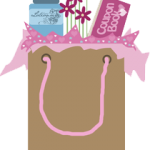




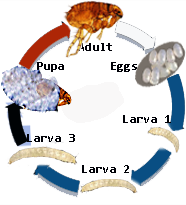


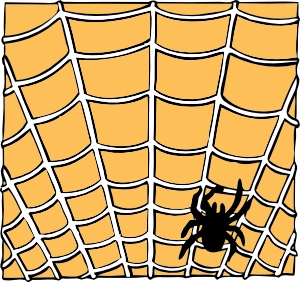



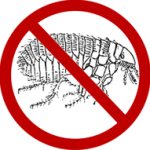
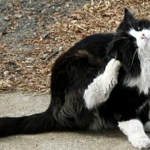


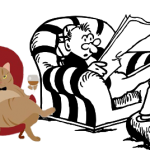






Bookmarked!! I really like your web site! I have found just in time what I need for my cat AND dog!
Thanks, TopCat! You rock!
Wow! You have given me a full toolbox I can use to customize a battle plan for my particular needs!
I so rarely comment, but I just had to take time to thank you for the obvious work you put into this and for bringing it home that we need to attack on more than one front! And to keep at it, not resting on one our ‘laurels’ once we manage to get one flea treatment in place. I just never knew that the measly little flea had so many forms to fight. They’re all ’round us! Eeeek!
I HATE to use chemicals and it amazes me that such simple, inexpensive things can work. I will be assembling what I need for the upcoming season..and NOW I know what I need and where and how to use my ‘weapons’. In my book too, the only good flea is a dead one! Thanks, TopCat for ALL your help here! I and my cats send you purr-sonal appreciation!
Sonja and Cats – Happy Hello!
Another ‘enlightened’ flea fighter – come to the ‘safer’ side of things!
I’m purr-sonally pleased that I helped you stoke your toolbox of fleas treatment tools that will keep you, your cats and the environment more comfortable and happy!
It’s Great to have another member of the “Dead Flea” – Done Safely Club!
It can be so utterly frustrating and stressful to do battle with this dastardly little beast. But so many of us fail due to lack of understanding of the life cycle of fleas. Once a chemical treatment is applied, many think their work is done… that that expensive flea poison will do the trick..and are furious when the fleas start to take over again in short shrift. Not to mention what might be happening to their cats, dogs or other pets from these pesticides.
Remember…one of the easiest ways to beat the little beasts is Prevention. Get started before the season warms up…get your tools in order. Start the combing, laundry, vacuuming regimens on a more frequent and regular basis if not already doing so and apply or freshen up the pre-treatments of DE and/or Borax – Salt, etc. to carpets, crannies, near the door outside, in bedding,e tc. Stock up on Nitenpyram (Capstar) and also Praziquantel (Tapeworm Tabs) and if you see your cats start to scratch…grab the flea comb and check it out. If you find any, you have the tools you need to take more agressive action. While it may be impossible to live life without a flea, especially if your pets are indoor/outdoor, you can limit the damage and the insanity with the simple routines mentioned – with regular, consistent application.
Here’s to a flea-free season ahead for you and your furry companions. And Thank YOU, Sonja, for taking YOUR time to comment and pass along the good vibes. If I were a cat, it would be my catnip! Puuuurrrrrs to you and yours!
TopCat
You have some truly fantastic posts. This was so helpful and timely for my needs.
Thanks for taking time out of your many duties to share your experience/expertise with the rest of us!
Wonderful Web site!
I’ve found soooo much helpful information here. The details in this article and your others help me understand in more depth. Lots of work here. Thank You for making the efforts!
Greetings to Both DeeDee and Ric!
Thank YOU for your input… You made my day. So GLAD I could help yours!
And sorry for the delayed response. Have been busy with Sanctuary duties and a new rescue, who was in hospice care. Just said ‘Good Bye’ ..but he did not end his journey here on this Life Plane alone and suffering, as he would have.
Your helpful comments are SO appreciated. May every dastardly flea be found and eradicated on your end!
Wishing you Flea-Free Success!
TopCat
Exceptional info! Must say, very educational, helpful and entertaining all in one! So glad I found this. Thanks for all your effort! Your new UK fan.
Melana, Hello!
A huge furball hug from us all here for your kind appraisal. I strive to help others on behalf of beloved Cat Loves everywhere.
Thank you for taking time to post your kind thoughts. Education is a key to making this world a better place for cats and animals of all species.
Thank you for any efforts in helping pass along information that can help others make wise decisions for the animals in their care. Their lives depend on us and knowledge and support are key.
With return appreciation,
TopCat
Wow–really marvelous work by TopCat! Just what I needed. Timely, dead on subject matter.
Flea season never ends here it seems.(California) I just don’t want to use the toxic topicals or other chemicals if possible. Looking forward to giving this all a test. More work, but far more peace of mind that I’m not poisoning my cats and dogs. Or me! Thanks so much for your substantial work here. It’s a gem!
Hey Gordy!
Really GLAD to hear you found the info you need! Fleas treatment applied as soon as you see your cat scratching can mean LOTS of work saved down the line. The flea population consists of only about 5% adults — the fleas we see. The REST are hiding out in the surroundings…waiting to emerge and grab their free meals and inject their miseries for us all!
Would LOVE the weather in California…but NOT the basically year-long flea season. My empathies are with you. But then…we all have it to a great extent, since fleas LOVE our heated winter environs. So, we’re really all in the same boat. Hmmm…maybe a move is in order after all?
Good luck on your flea warfare – and may you and your cats live in blissful flea-free peace!
Thanks, again, Gordy, for your supportive comments and for sharing your story with us!
TopCat